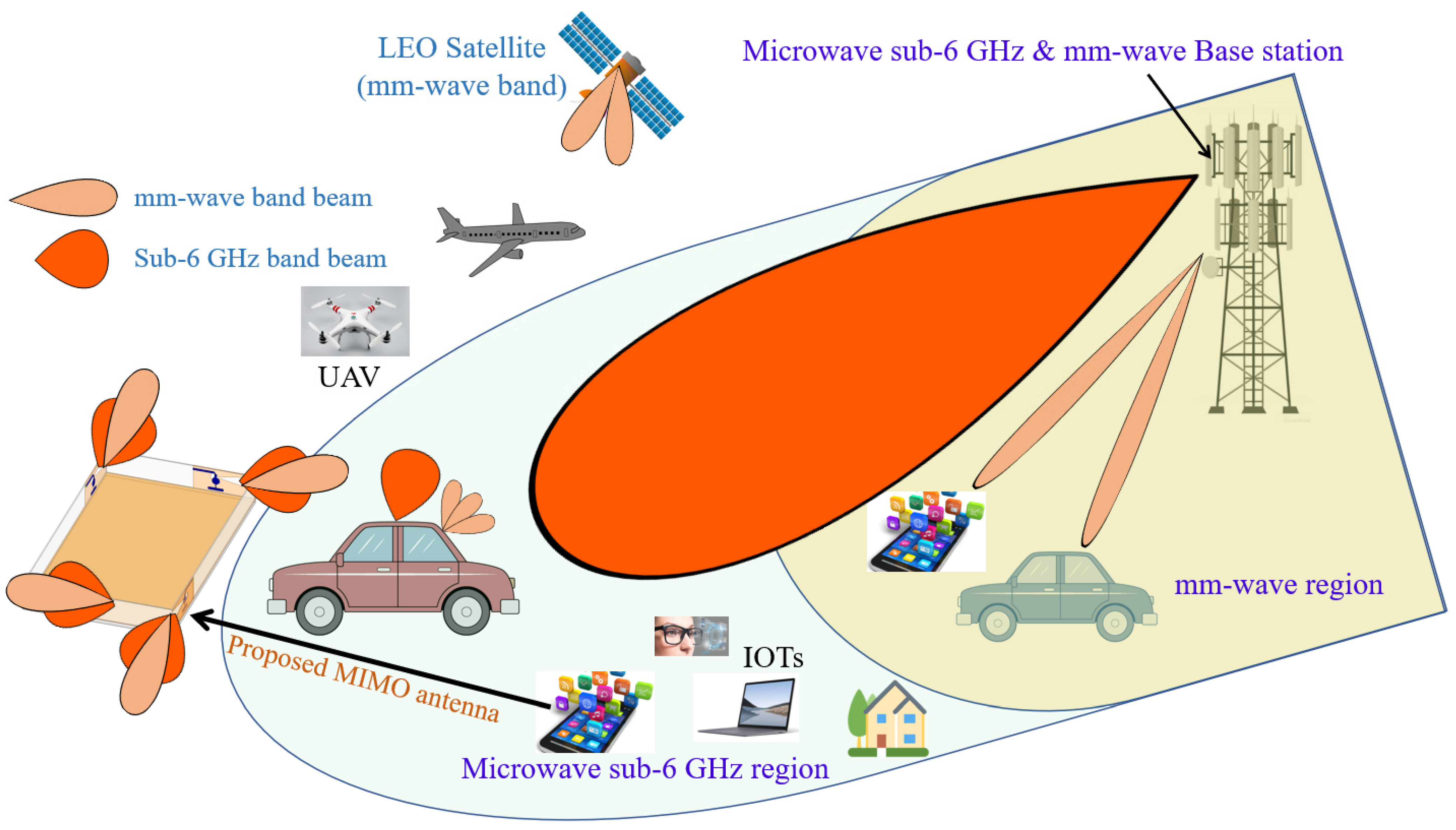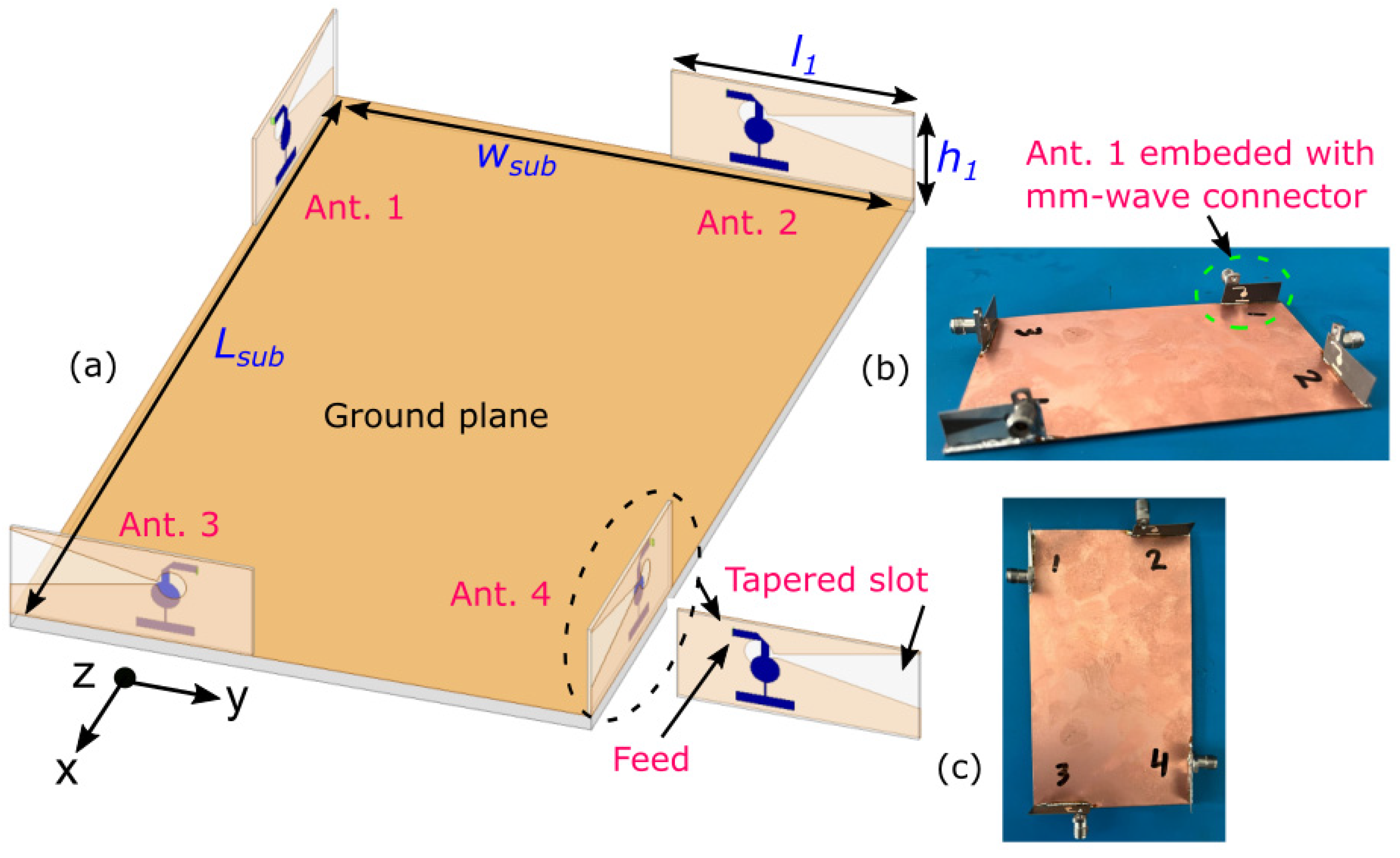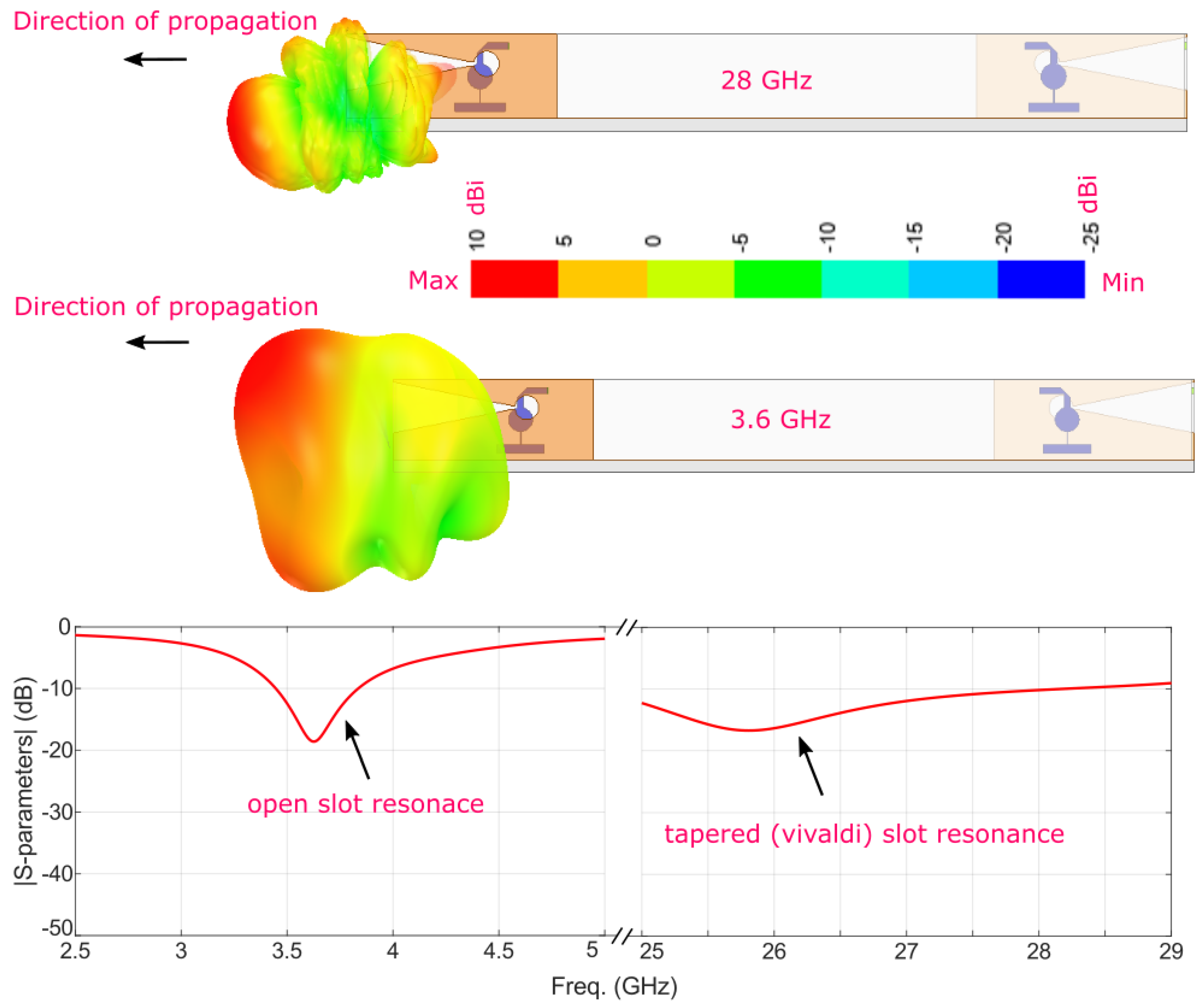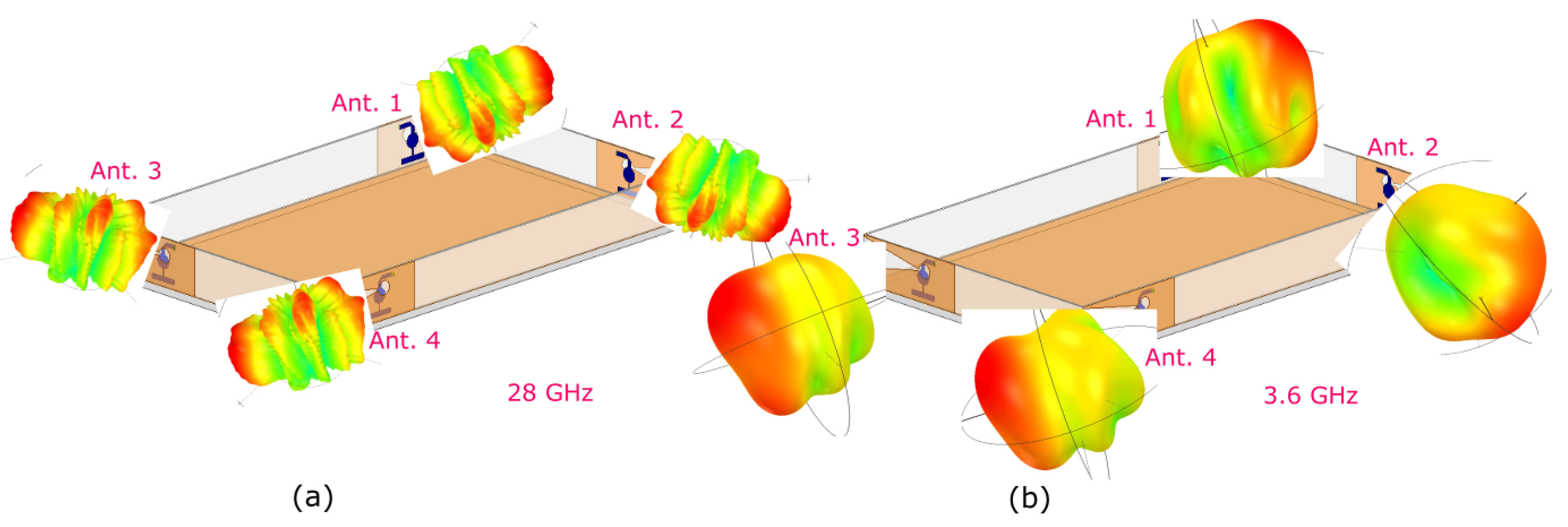5G/B5G Internet of Things MIMO Antenna Design
Abstract
:1. Introduction
2. MIMO Antenna & Design Procedure
3. Simulation and Measurement Results and Discussions
4. Comparison with State-of-the-Art Designs
5. Conclusions
Funding
Institutional Review Board Statement
Informed Consent Statement
Data Availability Statement
Conflicts of Interest
References
- Andrews, J.G.; Buzzi, S.; Choi, W.; Hanly, S.V.; Lozano, A.; Soong, A.C.; Zhang, J.C. What will 5G be? IEEE J. Sel. Areas Commun. 2014, 32, 1065–1082. [Google Scholar] [CrossRef]
- Asad, S.M.; Ansari, S.; Ozturk, M.; Rais, R.N.B.; Dashtipour, K.; Hussain, S.; Abbasi, H.Q.; Ali Imran, M. Mobility management-based autonomous energy-aware framework using machine learning approach in dense mobile networks. Signals 2020, 1, 170–187. [Google Scholar] [CrossRef]
- Pinto, J.F.; Silva, d.H.S.; Melo, F.; Fred, A. ScientIST: Biomedical Engineering Experiments Supported by Mobile Devices, Cloud and IoT. Signlas 2020, 1, 110–120. [Google Scholar] [CrossRef]
- Basenese, L. 5 Reasons to Let It Ride on 5G. Available online: https://www.smarteranalyst.com/bloggers-corner/resonant-resn-5-reasons-to-let-it-ride-on-5g/ (accessed on 10 December 2021).
- Parchin, N.O.; Al-Yasir, Y.I.A.; Ali, A.H.; Elfergani, I.; Noras, J.M.; Rodriguez, J.; Abd-Alhameed, R.A. Eight-element dual-polarized MIMO slot antenna system for 5G smartphone applications. IEEE Access 2019, 7, 15612–15622. [Google Scholar] [CrossRef]
- Sharawi, M.S.; Ikram, M.; Shamim, A. A two concentric slot loop based connected array MIMO antenna system for 4G/5G terminals. IEEE Trans. Antennas Propag. 2017, 65, 6679–6686. [Google Scholar] [CrossRef] [Green Version]
- Krishna, S. Design and Development of 5G Spectrum Massive MIMO Array Antennas for Base Station and Access Point Applications; Sharma, S.K., Ed.; ProQuest Dissertations Publishing: Ann Arbor, MI, USA, 2018. [Google Scholar]
- Ikram, M.; Sharawi, M.S.; Klionovski, K.; Shamim, A. A switched-beam millimeter-wave array with MIMO configuration for 5G applications. Microw. Opt. Technol. Lett. 2018, 60, 915–920. [Google Scholar] [CrossRef]
- Khalid, M.; Iffat Naqvi, S.; Hussain, N.; Rahman, M.; Mirjavadi, S.S.; Khan, M.J.; Amin, Y. 4-port mIMO antenna with defected ground structure for 5G millimeter wave applications. Eletronics 2020, 9, 71. [Google Scholar] [CrossRef] [Green Version]
- Gui, G.; Liu, M.; Tang, F.; Kato, N.; Adachi, F. 6G: Opening new horizons for integration of comfort, security, and intelligence. IEEE Wirel. Commun. 2020, 27, 126–132. [Google Scholar] [CrossRef]
- Bariah, L.; Mohjazi, L.; Muhaidat, S.; Sofotasios, P.C.; Kurt, G.K.; Yanikomeroglu, H.; Dobre, O.A. A prospective look: Key enabling technologies, applications and open research topics in 6G networks. IEEE Access 2020, 8, 174792–174820. [Google Scholar] [CrossRef]
- Hong, W. Solving the 5G mobile antenna puzzle: Assessing future directions for the 5G mobile antenna paradigm shift. IEEE Microw. Mag. 2017, 18, 86–102. [Google Scholar] [CrossRef]
- Sehrai, D.A.; Abdullah, M.; Altaf, A.; Kiani, S.H.; Muhammad, F.; Tufail, M.; Irfan, M.; Glowacz, A.; Rahman, S. A novel high gain wideband MIMO antenna for 5G millimeter wave applications. Eletronics 2020, 9, 1031. [Google Scholar] [CrossRef]
- Islam, S.; Zada, M.; Yoo, H. Low-pass filter based integrated 5G smartphone antenna for Sub-6-GHz and mm-wave bands. IEEE Trans. Antennas Propag. 2021, 69, 5424–5436. (In English) [Google Scholar] [CrossRef]
- Ikram, M.; Abbas, E.A.; Nguyen-Trong, N.; Sayidmarie, K.H.; Abbosh, A. Integrated frequency-reconfigurable slot antenna and connected slot antenna array for 4G and 5G mobile handsets. IEEE Trans. Antennas Propag. 2019, 67, 7225–7233. [Google Scholar] [CrossRef]
- Ikram, M.; Nguyen-Trong, N.; Abbosh, A. Hybrid antenna using open-ended slot for integrated 4G/5G mobile application. IEEE Antennas Wirel. Propag. Lett. 2020, 19, 710–714. [Google Scholar] [CrossRef]
- Bae, J.H.; Yoon, Y.J. 5G dual (S-/Ka-) band antenna using thick patch containing slotted cavity array. IEEE Antennas Wirel. Propag. Lett. 2021, 20, 1008–1012. (In English) [Google Scholar] [CrossRef]
- Wong, K.-L.; Tsai, C.-Y. Half-Loop frame antenna for the LTE metal-casing tablet device. IEEE Trans. Antennas Propag. 2017, 65, 71–81. [Google Scholar] [CrossRef]
- Rodriguez-Cano, R.; Zhang, S.; Zhao, K.; Pedersen, G.F. Reduction of main beam-blockage in an integrated 5G array with a metal-frame antenna. IEEE Trans. Antennas Propag. 2019, 67, 3161–3170. [Google Scholar] [CrossRef] [Green Version]
- Ikram, M. Multi-Functional Antenna Structures for 4G/5G Wireless Communication Devices. Ph.D. Thesis, The University of Queensland, St. Lucia, Australia, 2021. [Google Scholar]
- Sharawi, M.S. Printed multi-band MIMO antenna systems and their performance metrics [Wireless corner]. IEEE Antennas Propag. Mag. 2013, 55, 218–232. [Google Scholar] [CrossRef]
- Qureshi, U.; Khan, M.U.; Sharawi, M.S.; Burokur, S.N.; Mittra, R. Field decorrelation and isolation improvement in an MIMO antenna using an all-dielectric device based on transformation electromagnetics. Sensors 2021, 21, 7577. [Google Scholar] [CrossRef] [PubMed]
- Ikram, M.; Nguyen-Trong, N.; Abbosh, A. Multiband MIMO microwave and millimeter antenna system employing dual-function tapered slot structure. IEEE Trans. Antennas Propag. 2019, 67, 5705–5710. [Google Scholar] [CrossRef]










| References | Overall Size (mm3) | Sub-6 GHz Bands | mm-Wave Bands | MIMO Configurations | Realized Gain @ 28 GHz |
|---|---|---|---|---|---|
| [13] | 80 × 80 × 1.57 | Not covered | 28, 38 | 4-element at mm-wave | 10 |
| [14] | 157.7 × 70 × 0.51 | 3.5 | 28, 38 | 8-element at Sub-6 GHz 8-element at mm-wave | 8 |
| [16] | 150 × 75 × 0.51 | 0.8, 2 | 28 | 2-element at Sub-6 GHz 4-element at mm-wave | 11 |
| [17] | 22.8 × 22.8 × 3.4 | 3.5 | 28 | No | 12 |
| This Work | 100 × 60 × 10 | 3.6 | 28 | 4-element at Sub-6 GHz 4-element at mm-wave | 8 |
Publisher’s Note: MDPI stays neutral with regard to jurisdictional claims in published maps and institutional affiliations. |
© 2022 by the author. Licensee MDPI, Basel, Switzerland. This article is an open access article distributed under the terms and conditions of the Creative Commons Attribution (CC BY) license (https://creativecommons.org/licenses/by/4.0/).
Share and Cite
Ikram, M. 5G/B5G Internet of Things MIMO Antenna Design. Signals 2022, 3, 29-37. https://doi.org/10.3390/signals3010003
Ikram M. 5G/B5G Internet of Things MIMO Antenna Design. Signals. 2022; 3(1):29-37. https://doi.org/10.3390/signals3010003
Chicago/Turabian StyleIkram, Muhammad. 2022. "5G/B5G Internet of Things MIMO Antenna Design" Signals 3, no. 1: 29-37. https://doi.org/10.3390/signals3010003






